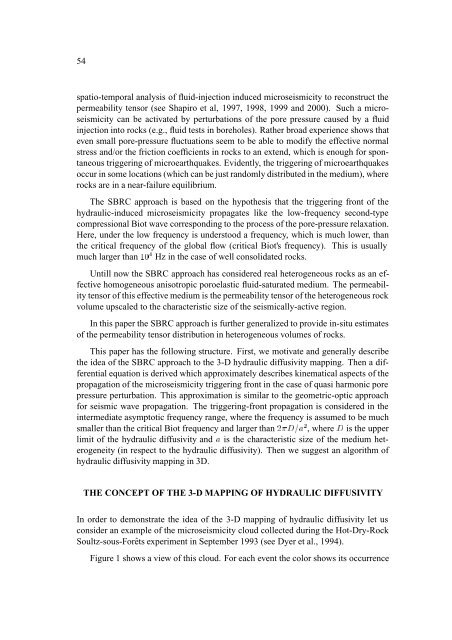Wave Inversion Technology - WIT
Wave Inversion Technology - WIT
Wave Inversion Technology - WIT
Create successful ePaper yourself
Turn your PDF publications into a flip-book with our unique Google optimized e-Paper software.
54<br />
spatio-temporal analysis of fluid-injection induced microseismicity to reconstruct the<br />
permeability tensor (see Shapiro et al, 1997, 1998, 1999 and 2000). Such a microseismicity<br />
can be activated by perturbations of the pore pressure caused by a fluid<br />
injection into rocks (e.g., fluid tests in boreholes). Rather broad experience shows that<br />
even small pore-pressure fluctuations seem to be able to modify the effective normal<br />
stress and/or the friction coefficients in rocks to an extend, which is enough for spontaneous<br />
triggering of microearthquakes. Evidently, the triggering of microearthquakes<br />
occur in some locations (which can be just randomly distributed in the medium), where<br />
rocks are in a near-failure equilibrium.<br />
The SBRC approach is based on the hypothesis that the triggering front of the<br />
hydraulic-induced microseismicity propagates like the low-frequency second-type<br />
compressional Biot wave corresponding to the process of the pore-pressure relaxation.<br />
Here, under the low frequency is understood a frequency, which is much lower, than<br />
the critical frequency of the global flow (critical Biot's frequency). This is usually<br />
much larger than 10 4 Hz in the case of well consolidated rocks.<br />
Untill now the SBRC approach has considered real heterogeneous rocks as an effective<br />
homogeneous anisotropic poroelastic fluid-saturated medium. The permeability<br />
tensor of this effective medium is the permeability tensor of the heterogeneous rock<br />
volume upscaled to the characteristic size of the seismically-active region.<br />
In this paper the SBRC approach is further generalized to provide in-situ estimates<br />
of the permeability tensor distribution in heterogeneous volumes of rocks.<br />
This paper has the following structure. First, we motivate and generally describe<br />
the idea of the SBRC approach to the 3-D hydraulic diffusivity mapping. Then a differential<br />
equation is derived which approximately describes kinematical aspects of the<br />
propagation of the microseismicity triggering front in the case of quasi harmonic pore<br />
pressure perturbation. This approximation is similar to the geometric-optic approach<br />
for seismic wave propagation. The triggering-front propagation is considered in the<br />
intermediate asymptotic frequency range, where the frequency is assumed to be much<br />
smaller than the critical Biot frequency and larger than 2D=a 2 , where D is the upper<br />
limit of the hydraulic diffusivity and a is the characteristic size of the medium heterogeneity<br />
(in respect to the hydraulic diffusivity). Then we suggest an algorithm of<br />
hydraulic diffusivity mapping in 3D.<br />
THE CONCEPT OF THE 3-D MAPPING OF HYDRAULIC DIFFUSIVITY<br />
In order to demonstrate the idea of the 3-D mapping of hydraulic diffusivity let us<br />
consider an example of the microseismicity cloud collected during the Hot-Dry-Rock<br />
Soultz-sous-Forêts experiment in September 1993 (see Dyer et al., 1994).<br />
Figure 1 shows a view of this cloud. For each event the color shows its occurrence







